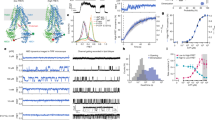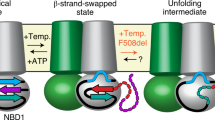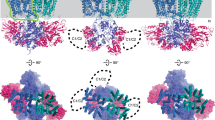Abstract
ABC (ATP-binding cassette) proteins constitute a large family of membrane proteins that actively transport a broad range of substrates. Cystic fibrosis transmembrane conductance regulator (CFTR), the protein dysfunctional in cystic fibrosis, is unique among ABC proteins in that its transmembrane domains comprise an ion channel. Opening and closing of the pore have been linked to ATP binding and hydrolysis at CFTR's two nucleotide-binding domains, NBD1 and NBD2 (see, for example, refs 1, 2). Isolated NBDs of prokaryotic ABC proteins dimerize upon binding ATP, and hydrolysis of the ATP causes dimer dissociation3,4,5. Here, using single-channel recording methods on intact CFTR molecules, we directly follow opening and closing of the channel gates, and relate these occurrences to ATP-mediated events in the NBDs. We find that energetic coupling6 between two CFTR residues, expected to lie on opposite sides of its predicted NBD1–NBD2 dimer interface, changes in concert with channel gating status. The two monitored side chains are independent of each other in closed channels but become coupled as the channels open. The results directly link ATP-driven tight dimerization of CFTR's cytoplasmic nucleotide-binding domains to opening of the ion channel in the transmembrane domains. This establishes a molecular mechanism, involving dynamic restructuring of the NBD dimer interface, that is probably common to all members of the ABC protein superfamily.
This is a preview of subscription content, access via your institution
Access options
Subscribe to this journal
Receive 51 print issues and online access
$199.00 per year
only $3.90 per issue
Buy this article
- Purchase on Springer Link
- Instant access to full article PDF
Prices may be subject to local taxes which are calculated during checkout




Similar content being viewed by others
References
Gunderson, K. L. & Kopito, R. R. Conformational states of CFTR associated with channel gating: the role of ATP binding and hydrolysis. Cell 82, 231–239 (1995)
Carson, M. R., Travis, S. M. & Welsh, M. J. The two nucleotide-binding domains of cystic fibrosis transmembrane conductance regulator (CFTR) have distinct functions in controlling channel activity. J. Biol. Chem. 270, 1711–1717 (1995)
Hopfner, K. P. et al. Structural biology of Rad50 ATPase: ATP-driven conformational control in DNA double-strand break repair and the ABC-ATPase superfamily. Cell 101, 789–800 (2000)
Moody, J. E., Millen, L., Binns, D., Hunt, J. F. & Thomas, P. J. Cooperative, ATP-dependent association of the nucleotide binding cassettes during the catalytic cycle of ATP-binding cassette transporters. J. Biol. Chem. 277, 21111–21114 (2002)
Smith, P. C. et al. ATP binding to the motor domain from an ABC transporter drives formation of a nucleotide sandwich dimer. Mol. Cell 10, 139–149 (2002)
Serrano, L., Horovitz, A., Avron, B., Bycroft, M. & Fersht, A. R. Estimating the contribution of engineered surface electrostatic interactions to protein stability by using double-mutant cycles. Biochemistry 29, 9343–9352 (1990)
Davidson, A. L. & Chen, J. ATP-binding cassette transporters in bacteria. Annu. Rev. Biochem. 73, 241–268 (2004)
Higgins, C. F. & Linton, K. J. The ATP switch model for ABC transporters. Nature Struct. Mol. Biol. 11, 918–926 (2004)
Locher, K. P., Lee, A. T. & Rees, D. C. The E. coli BtuCD structure: a framework for ABC transporter architecture and mechanism. Science 296, 1091–1098 (2002)
Chen, J., Lu, G., Lin, J., Davidson, A. L. & Quiocho, F. A. A tweezers-like motion of the ATP-binding cassette dimer in an ABC transport cycle. Mol. Cell 12, 651–661 (2003)
Janas, E. et al. The ATP hydrolysis cycle of the nucleotide-binding domain of the mitochondrial ATP-binding cassette transporter Mdl1p. J. Biol. Chem. 278, 26862–26869 (2003)
Verdon, G. et al. Formation of the productive ATP-Mg2+-bound dimer of GlcV, an ABC-ATPase from Sulfolobus solfataricus. J. Mol. Biol. 334, 255–267 (2003)
Horn, C., Bremer, E. & Schmitt, L. Nucleotide dependent monomer/dimer equilibrium of OpuAA, the nucleotide-binding protein of the osmotically regulated ABC transporter OpuA from Bacillus subtilis. J. Mol. Biol. 334, 403–419 (2003)
Vergani, P., Nairn, A. C. & Gadsby, D. C. On the mechanism of MgATP-dependent gating of CFTR Cl- channels. J. Gen. Physiol. 121, 17–36 (2003)
Basso, C., Vergani, P., Nairn, A. C. & Gadsby, D. C. Prolonged nonhydrolytic interaction of nucleotide with CFTR's NH2-terminal nucleotide binding domain and its role in channel gating. J. Gen. Physiol. 122, 333–348 (2003)
Aleksandrov, L., Aleksandrov, A. A., Chang, X. B. & Riordan, J. R. The first nucleotide binding domain of cystic fibrosis transmembrane conductance regulator is a site of stable nucleotide interaction, whereas the second is a site of rapid turnover. J. Biol. Chem. 277, 15419–15425 (2002)
Tombline, G., Bartholomew, L. A., Urbatsch, I. L. & Senior, A. E. Combined mutation of catalytic glutamate residues in the two nucleotide binding domains of P-glycoprotein generates a conformation that binds ATP and ADP tightly. J. Biol. Chem. 297, 31212–31220 (2004)
Lockless, S. W. & Ranganathan, R. Evolutionarily conserved pathways of energetic connectivity in protein families. Science 286, 295–299 (1999)
Knowles, J. Enzyme-catalyzed phosphoryl transfer reactions. Annu. Rev. Biochem. 49, 877–919 (1980)
Bakos, É. et al. Characterization of the human multidrug resistance protein containing mutations in the ATP-binding cassette signature region. Biochem. J. 323, 777–783 (1997)
Fersht, A. Structure and Mechanism in Protein Science (W. H. Freeman, New York, 1999)
Hung, L. W. et al. Crystal structure of the ATP-binding subunit of an ABC transporter. Nature 396, 703–707 (1998)
Verdon, G., Albers, S. V., Dijkstra, B. W., Driessen, A. J. M. & Thunnissen, A.-M. W. Crystal structures of the ATPase subunit of the glucose ABC transporter from Sulfolobus solfataricus: nucleotide-free and nucleotide-bound conformations. J. Mol. Biol. 330, 343–358 (2003)
Lerner-Marmarosh, N., Gimi, K., Urbatsch, I. L., Gros, P. & Senior, A. E. Large scale purification of detergent-soluble P-glycoprotein from Pichia pastoris cells and characterization of nucleotide binding properties of wild-type, Walker A, and Walker B mutant proteins. J. Biol. Chem. 274, 34711–34718 (1999)
Qian, Y.-M. et al. Characterization of binding of leukotriene C4 by human multidrug resistance protein 1. Evidence of differential interactions with NH2- and COOH-proximal halves of the protein. J. Biol. Chem. 276, 38636–38644 (2001)
Austermuhle, M. I., Hall, J. A., Klug, C. S. & Davidson, A. L. Maltose-binding protein is open in the catalytic transition state for ATP hydrolysis during maltose transport. J. Biol. Chem. 279, 28243–28250 (2004)
Hopfner, K.-P. & Tainer, J. A. Rad50/SMC proteins and ABC transporters: unifying concepts from high-resolution structures. Curr. Opin. Struct. Biol. 13, 249–255 (2003)
Csanády, L. Rapid kinetic analysis of multichannel records by a simultaneous fit to all dwell-time histograms. Biophys. J. 78, 785–799 (2000)
Acknowledgements
We thank L. Csanády and G. Szakács for discussion. The work was supported by an NIH grant to D.C.G.
Author information
Authors and Affiliations
Corresponding authors
Ethics declarations
Competing interests
The authors declare that they have no competing financial interests.
Supplementary information
Supplementary Notes
Thermodynamic double mutant cycles. Derivation of equations used to quantify energetic coupling. (DOC 72 kb)
Supplementary Table 1
Kinetic Parameters of WT and mutant CFTR channels. Part A: kinetic parameters describing single-channel gating, obtained from patches containing a small number of channels (for example Figs 2c, 3b and 4b). Part B: Current decay time-constants, obtained from patches containing hundreds of channels (for example Fig. 1b). (DOC 23 kb)
Rights and permissions
About this article
Cite this article
Vergani, P., Lockless, S., Nairn, A. et al. CFTR channel opening by ATP-driven tight dimerization of its nucleotide-binding domains. Nature 433, 876–880 (2005). https://doi.org/10.1038/nature03313
Received:
Accepted:
Issue Date:
DOI: https://doi.org/10.1038/nature03313
This article is cited by
-
Molecular dynamics study of Cl− permeation through cystic fibrosis transmembrane conductance regulator (CFTR)
Cellular and Molecular Life Sciences (2023)
-
Structure and efflux mechanism of the yeast pleiotropic drug resistance transporter Pdr5
Nature Communications (2021)
-
A topological switch in CFTR modulates channel activity and sensitivity to unfolding
Nature Chemical Biology (2021)
-
Mechanics and pharmacology of substrate selection and transport by eukaryotic ABC exporters
Nature Structural & Molecular Biology (2019)
-
CFTR IVS8 Poly-T Variation Affects Severity of Acute Pancreatitis in Women
Journal of Gastrointestinal Surgery (2019)
Comments
By submitting a comment you agree to abide by our Terms and Community Guidelines. If you find something abusive or that does not comply with our terms or guidelines please flag it as inappropriate.



